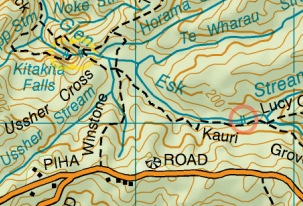Toroanui Falls
Starting some distance up the coast north of the Waitakeres, at Muriwai,
there are two waterfalls on the Okiritoto Stream. Toroanui Falls is on private land, it can be
seen across the fields from the edge of publicly accessible land in Woodhill Forest. It appears
to be quite a good-sized waterfall, at least from this distance.
The updated LINZ map now gives its height as 15m (50 feet), which corresponds with the contoured air
photo (50 feet).

The forest extends to a line between Lake Okaihau and the Okiritoto Stream. Sadly, this area has recently been logged, so is probably not a pleasant stroll from the forest gate at Coast Road any more.
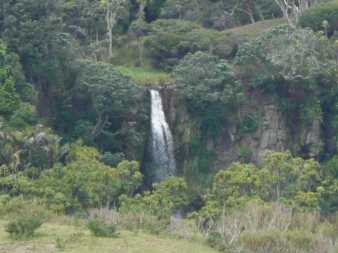
Okiritoto Falls
Okiritoto Falls is, according to the map, 200 yards further upstream, but can't be seen from the edge of the forest. However, here's an excellent picture of it (many thanks to Matt and Sandi).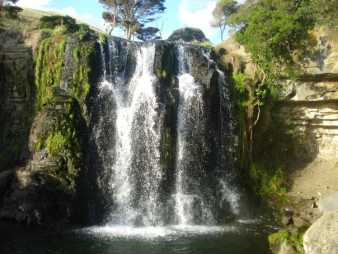
The earlier edition of the LINZ map gave the height as 5m (16 feet), but it always looked far more than that.
This picture is a scan from the Hercules episode Resurrection, in which a character jumps off the fall. Assuming the 'stuntie' is five feet tall (which is conservative), the waterfall scales at 30 feet (9m), which seems more like it.
In fact the current map shows it as 8m (26feet) which agrees with the contoured air photo.
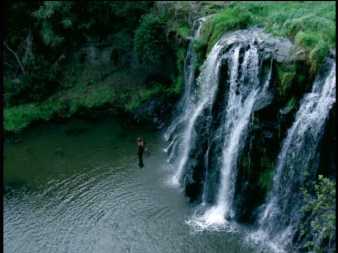
Taiapa fall
Just for completeness, and since it's on the map... heading upstream, the valley of the Okiritoto Stream (which becomes the Raurataua Stream) curves back round towards the coast. Alongside Taiapa Road is shown a waterfall - which can indeed be seen from the road, though not from the best angle. It's about ten feet high where it disappears over those rock slabs.Taken in late spring, I haven't fiddled with the colours, it really was that green.
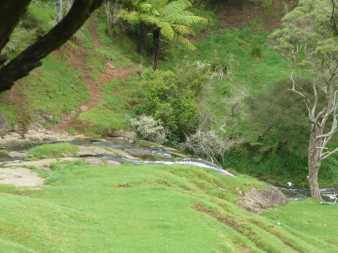

Mokoroa Falls
| In mid-October 2018, DoC (Department of Conservation) reopened Mokoroa Falls Track, Mokoroa Stream Track and Goldies Bush Track. Status:Open |
Just south of Taiapa Road, on the northern fringe of the Waitakere Ranges proper, is the seldom-visited Mokoroa Falls, reached by a track off Horseman Road. (It's a mile from the falls mentioned above, but fifteen miles by road - the Waitakeres are mercifully undeveloped as far as connecting roads go). The falls form a horseshoe in conjunction with a very small (but higher) waterfall on the Houheria Stream (entering from right of photo).
Top photo from the viewpoint at the end of the Mokoroa Falls Track, lower photo and Houheria Falls from the stream bed. These photos taken after a lot of heavy rain, so the falls are flowing much better than usual.
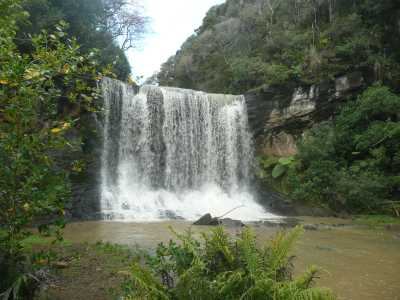
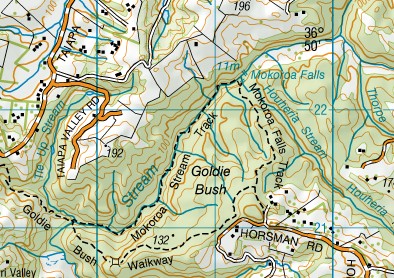
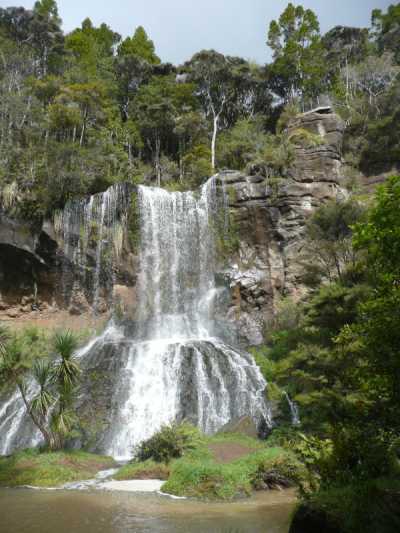
Houheria Falls
This is the fall on the Houheria Stream, looking very scenic after plenty of rain. They're normally just a trickle.The safety fence of the viewpoint at the end of the Mokoroa Falls Track can be seen at top right. (There are connecting steps up from the stream bed.)
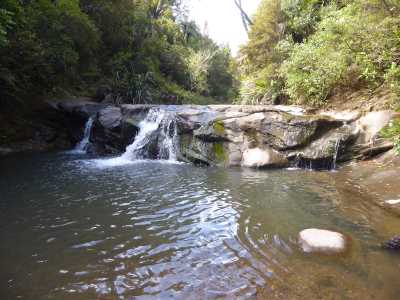
Mokoroa Stream track
| Open |
The stream/track from Mokoroa Falls down to the Goldies Bush track can be followed in dry weather. There are a few low falls/cascades where the stream falls over sandstone edges. There are also a number of stream crossings (about 15, but I lost count) on the route.
This was the first fall (heading downstream from the main falls). The track crosses the crest of the fall then clambers down the face to follow the sloping rock edge on right.
The flow on this occasion was much lower than when the pictures of the main falls were taken.
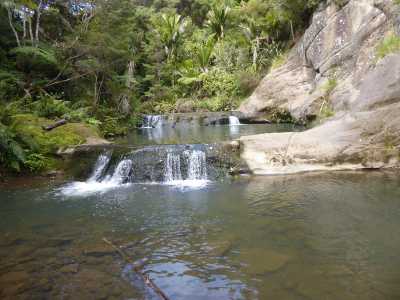
The alternative is to cross the crest of the upper fall, pass both pools on the easy stream bank at the left of photo, and cross back in the shallow ford where the camera was. This is more attractive at low flows (like this one).
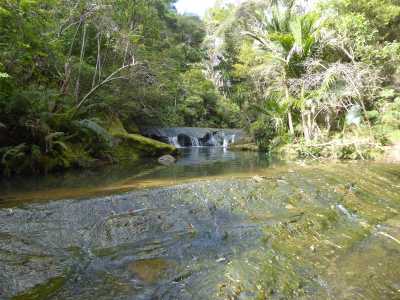
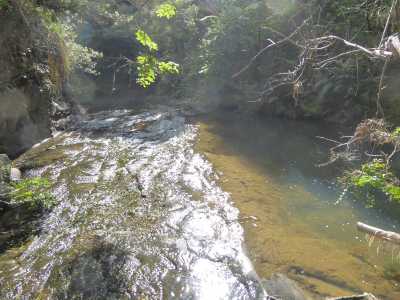
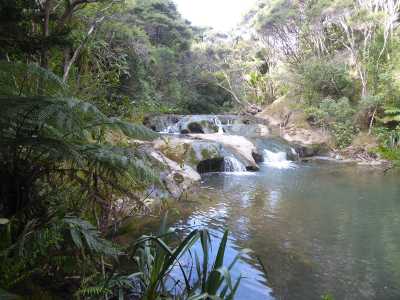
Wainamu Falls
| Lake Wainamu Track (around the lake), and the dunes are open. (Kauri don't grow on sand or damp areas). The lowest waterfall adjacent to the track is probably accessible, the others immediately above may or may not be. Houghtons Track and the Wainamu Stream above the waterfalls is definitely off limits. |
The Mokoroa Stream joins the Waitakere River just inland from Bethells Beach. On the eastern side of the river, the Waiti Stream flows in, flanked by a stretch of sand dunes. At the upper end of the dunes, the Wainamu Stream joins, flowing down from Lake Wainamu, which is held back by the dunes. (The walk up the sandy bed of the Waiti-Wainamu streams to the lake, and back over the dunes is a pleasant excursion. In summer, many people swim in the lake from the dune side).
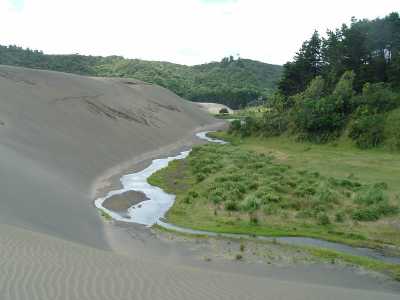
Height 4 1/2m (according to airphoto).
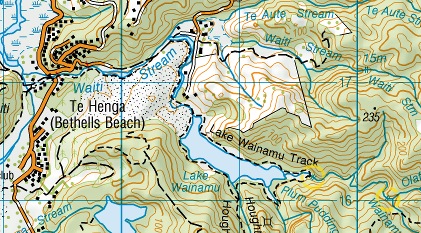
The next one upstream (only makes a good showing at high flows like this)
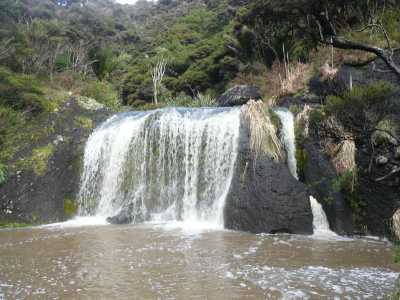
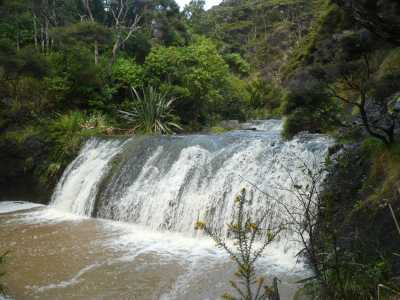
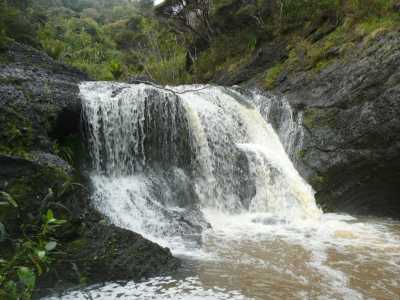
Upper Wainamu Falls
| The Wainamu Stream valley and hence the upper falls will definitely be a no-go area. |
Just a half mile upstream (but an hour's trekking up the streambed and through the bush), just below the crossing of the Wainamu Bush Track, is another flight of falls. The first fall is a low cascade, this is the second and third falls in the series. The contour map suggests they're approximately 5m (16 feet) in height each. Unfortunately the bush does not permit a view of the full flight.
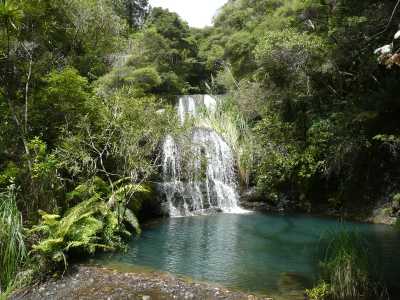

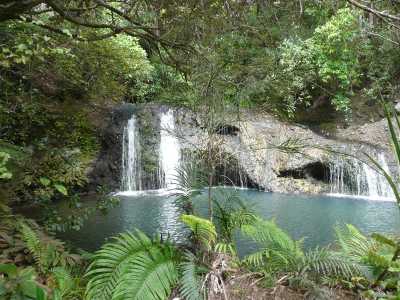
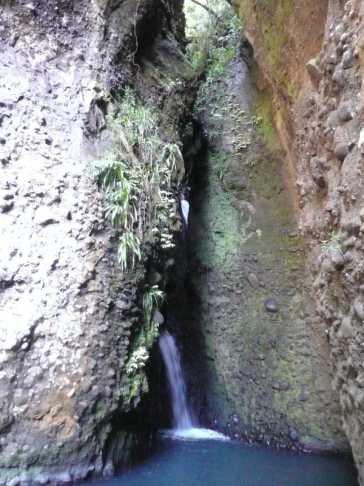
The Cascades
| The Auckland City Walk and other tracks in the area are definitely Closed. |
These are among the most-visited - and least seen - falls in the Waitakeres. Paradox? Yes. The Cascades are up a short side-track off the popular Auckland City Walk which runs alongside the Waitakere River stream from the nearby Cascades Park, and they're a good size, but remarkably bashful. As you follow the track up the stream, you sidle round the base of an enormous boulder which has fallen from the overhanging cliffs above. Scrambling over (or under) more huge boulders, with the cliffs closing in overhead, you come upon a small deep pool with a narrow slot at the far end which angles out of sight. With some very cautious climbing round the boulders, or venturing knee-deep in the pool, you can just see the bottom tier of the cascade, and a glimpse of falling water much further up.
This is only really practical in fine weather, when the rocks aren't dangerously slippery, so most visitors never even see this much.
The total fall from the valley above to the pool appears to be about 20 metres, though without doing some canyoning it's impossible to tell how many drops make up the descent.
Waitakere Falls
|
The top two views are from Pukematekeo; the access road to the summit is still open. The access road to the Waitakere Dam is still open. Other tracks in the area - including Anderson Track, West Tunnel Mouth Track and the tramline - are closed. |
And now, the real thing - Waitakere dam and waterfall, seen from Pukematekeo viewpoint above the Scenic Drive. This was after a wet season and prolonged heavy rain, on one of the rare occasions when the dam was full and the fall was allowed to flow. Taken with a long lens on a very overcast day, hence my excuse for the under-exposure.
However, under current regulations, the stream and waterfall are now allowed to flow more regularly - which ironically means the chances of a high flow such as this one are reduced.
The lower photo, also from Pukematekeo, shows the more usual flow over the fall, though the clouds were kind in highlighting the fall and dam.
The dam can be reached by a walking track from the Scenic Drive - follow Anderson Track and West Tunnel Mouth Track to reach the narrow-gauge tramline that was built for the construction of the dam.

Waitakere waterfall, seen from the tramline a quarter mile away (between the short tunnel and Kelly Stream). This is the one spot that gives a view of the waterfall, the thick 'bush' (rain forest) screens the view from everywhere else.
It may be possible to get a better view from the stream bed, but access to 'the valley below the dam' is officially forbidden due to the danger of rockfall from the overhanging cliff seen on the left of the photo.
The Waitakere Ranges are not very high - nothing over 1500 feet - so I was very surprised to find that this fall is the third highest in North Island, after Wairere Falls (502') and Ananui Falls (345'). Waitakere Falls are shown as 95m on the contour map, and a detailed survey carried out to assess the stability of the cliff makes them 94.5m (310 feet) high.
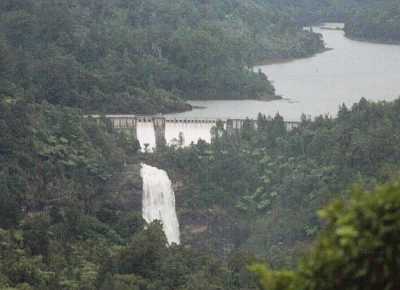

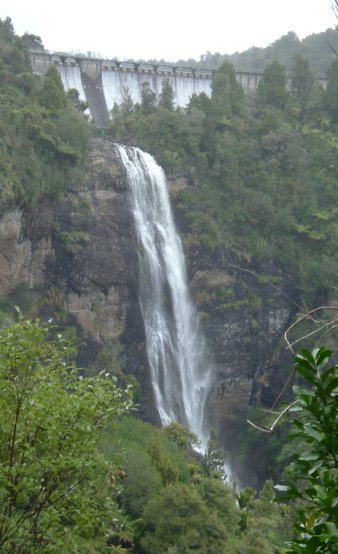
There is no official track to it and access is (probably) forbidden, depending how far 'the valley below the dam' is considered to extend, for which reason the source of this shot prefers to remain anonymous.
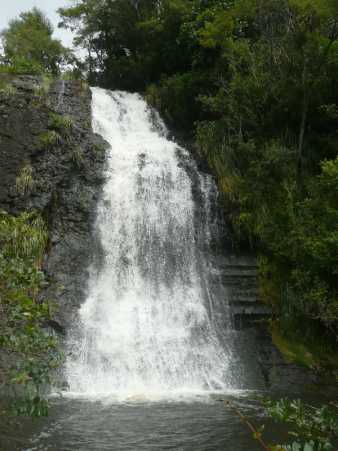
Marawhara fall
| Marawhara Walk, from the road to the stream crossing, is still open. Whites Track is closed, and so, probably, is the track upstream to the waterfall. |
In north Piha, from the point where the short streamside Marawhara Walk becomes Whites Track, crosses the stream and heads off up the hill, an unofficial but well-trodden track continues up the Marawhara Stream. And this (right) is where it's headed - at the top end of the little Marawhara gorge is this ten-foot fall, which plunges into a deep pool making a popular swimming hole for the locals.
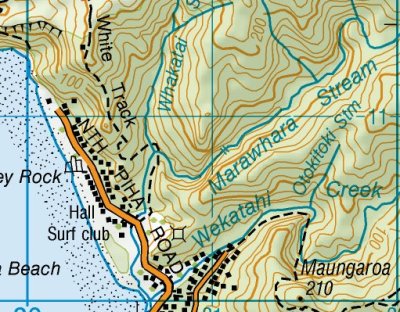

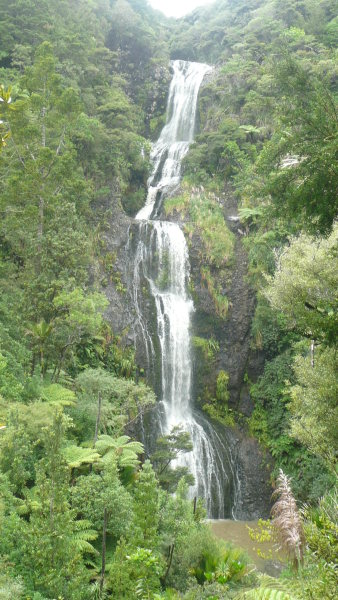
Taken after rain on a slightly misty day
Kitekite Falls
|
As of January 2019, Kitekite Track is reported to be Open from Glen Esk Rd as far as the falls.
Connect Track is open as far as the top of the falls. It is likely that all other tracks beyond that are still Closed. |
Kitekite Falls lies half a mile up the valley from the head of Glen Esk Road inland from Piha, above the short but steep-sided Kitekite Gorge. The walking tracks to the base of the falls climb up the sides of the valley to avoid the gorge.
Recently a small gap has been cleared in the bush to permit a full view of the falls from the approach track. Previously, it was only possible to photograph the fall in several sections (by looking through different gaps in the trees) and try and join the results together.
A short but moderately steep walking track, Connect Track, leads up to the top of the falls and on into the network of walking tracks in the upper valley.
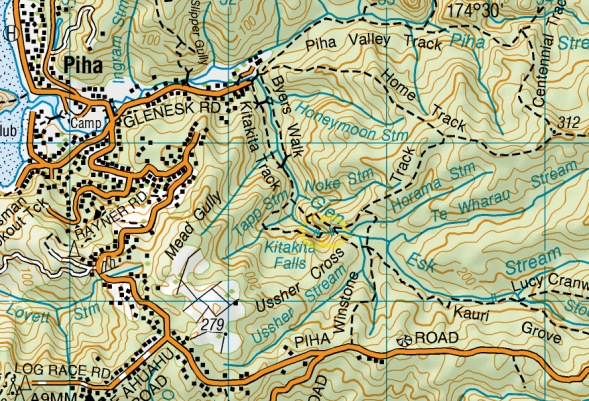
The best and most pleasant approach is from Glen Esk Road via Byers Walk or Kitekite Track. The approach down Winstone Track to the top of the falls may look shorter, but it's a stiff climb from the bottom of the falls back up to your car.

And in afternoon sunshine
Unlike most falls, these are well angled to catch the late afternoon sun, at least in summer.
A Guide to New Zealand Waterfalls says the falls 'plunge 40m (131ft) in three ... leaps'
and the accompanying illustration in that book, taken from the foot of the falls, shows only the
lower three steps. If the upper falls are taken into account, the total is certainly higher than that.
The uppermost fall, by direct measurement with a length of rope, is 4.5m for the just-distinguishable step at the
top and 15.8m for the main drop. That's 20.3m or 67 feet. The contoured airphoto (though it's hard to
read due to shadows) makes the top fall 19m, the next sloping cascade 12m, and the three-tiered lower
fall 30m (100 feet), for a total of 61m or 200 feet.
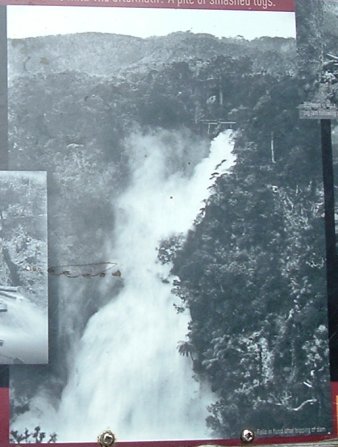
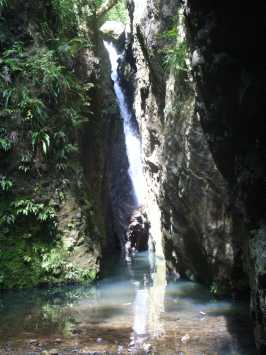
50 yards below the main falls, the stream drops into the narrow, sheer-sided little Kitekite Gorge.
This lower fall can be seen (with some caution) from beside its crest, but not from below unless you wish to
scramble up the gorge itself from the bottom end (as I did for this photo).
There is a piece of tree stump that looks big enough to be kauri, jammed in the narrow cleft at the foot
of the fall - if so, it must be at least 80 years old.
This caused me one of the spookiest moments of my life. As you can see, the gorge is sheer sided, with
only one way in - the way I had come - and nowhere to hide. I was absolutely alone. I lined up the
camera, took my photo, and then as I looked at the result in the LCD screen I could feel the hairs creeping up on the
back of my neck because there in the picture was a man standing looking up at the fall. I looked up and -
there was nobody there. You can 'see' him clearly in the thumbnail at the left. It was an illusion caused by
light and shadow, reflections and the big kauri stump, but very convincing - it's easier to see the
reality in the full-size photo.
This fall - measured with a piece of string from the top - is, to a best estimate, 41 feet (12.5m) high.
Karekare Falls
|
The short length of Taraire Track from the road to the waterfall is open. And so is Pohutukawa
Glade Walk to the beach. The rest of Taraire Track and LaTrobe Track are closed (and so are the waterfalls up the Company Stream and Karekare Stream). |
The next valley south of Piha is Karekare, site of the other notable Waitakere waterfall. The falls are just a half mile up the valley from the beach, on Company Stream, and it is just a short walk from the road down the track to the foot of the falls themselves.
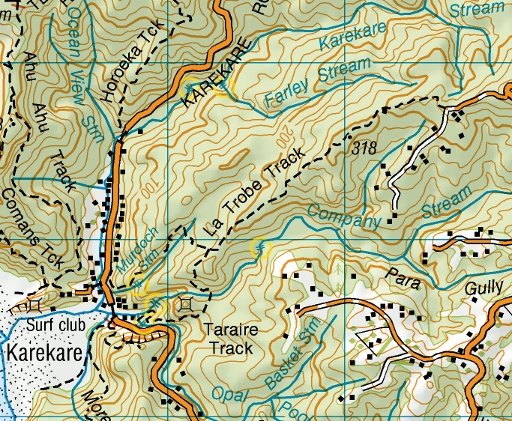


This was taken from Lone Kauri Road after heavy rain when there was much more water in the falls than usual, and on another overcast day (under-exposed again...)
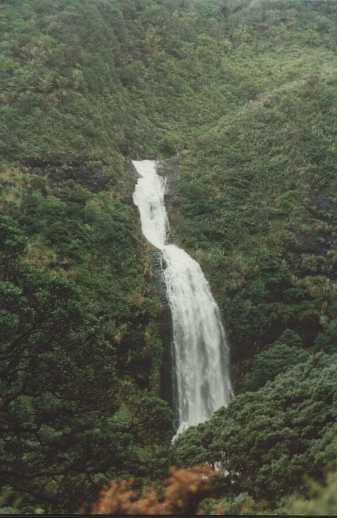

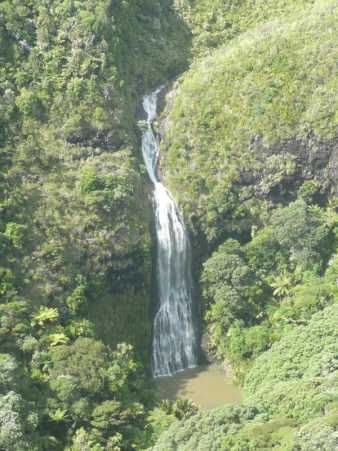
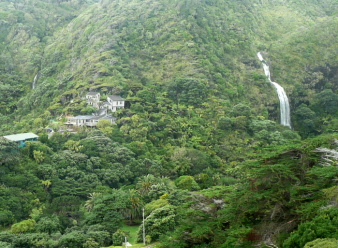
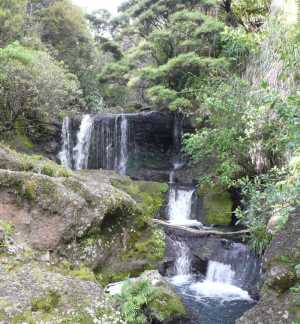
It can be reached by taking Taraire Track to where it crosses the stream, then following the stream eastwards (upstream) - and I mean follow it, do not try to take shortcuts unless you like being lost in the bush!
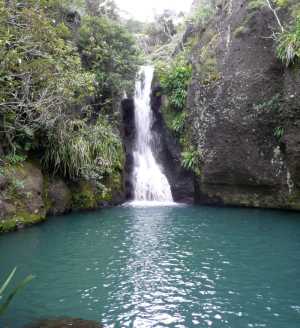

Pararaha
|
Cowan Stream and the Pararaha are both, predictably, very closed. The track from Karekare along the back of the beach through Tunnel Point as far as the start of the Pararaha swamps is open, but that's all. |
The next valley south of Karekare is the Pararaha valley. I've seen it described as 'remote' in the guidebooks, possibly because there's no road access, but on a sunny Sunday I've encountered four or five groups of adventurers enjoying their 'wilderness experience' - busier than most of the tracks nearer civilisation. The Cowan Stream section splits off near the top end of the valley, but since it's customary to follow it downstream, I'll start at the top of Cowan Stream.
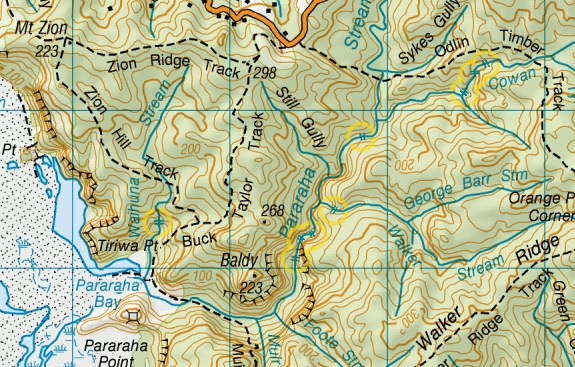
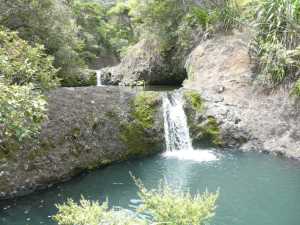
Cowan Stream
WARNING: Both Cowan Stream and the Pararaha are 'experienced trampers only' routes. Don't attempt alone, or late in the afternoon. The streamside track on Cowan Stream is quite easy to follow, but can be hard to find, not least because it keeps crossing the stream. You do not want to be trying to find it in the bush with dusk coming on.You should allow at least an hour and a half to follow the Cowan Stream from Odlins Track to where it joins the Pararaha. (An hour if you know the way and keep moving, OK?)

From Lone Kauri Road, Odlins Timber Track descends with many steps to cross the Pararaha Stream then climbs over a stiff hill, and down to the crossing of Cowan Stream. Heading downstream from there, small waterfalls begin almost at once. Most of these are only four or five feet high, but they fall into nice deep large pools.

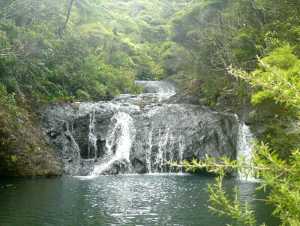
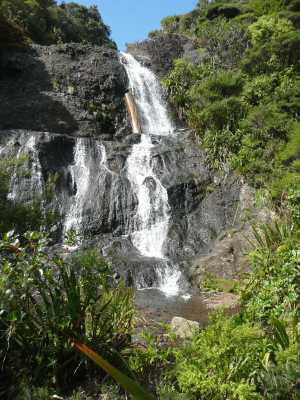
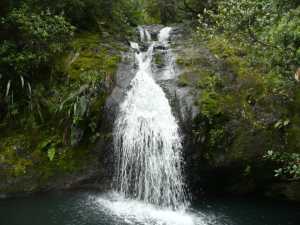
(Addendum: A half-full Coke bottle works better than a piece of wood; its shape is better adapted to sliding down rocks and being hauled up again without slipping, and one can feel more readily when it has reached the pool below.)
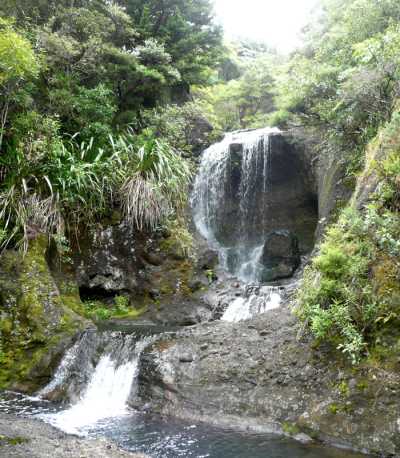
Then a couple of minor drops...

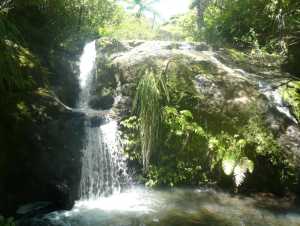
Below this the track follows the stream for what seems like quite a long way to the Pararaha, from where it's just an easy few hundred yards upstream to reach Odlins Track again; or (much more difficult) head downstream on the Pararaha Valley Route (but see the caution below).
Pararaha Valley Route
| Closed. |
The 'Pararaha Valley Route' (it doesn't qualify as a track) follows the stream for about two miles, from where Odlins Track crosses the stream, down to Muir Camp, half a mile inland from the coastal swamps. This section takes at least two hours if you don't know the route well and involves some difficult route-finding and tricky scrambling where sections of track climb over outcrops up the sheer valley side. Caution: Don't start the Pararaha section late in the afternoon as the route is far from obvious and impossible to find in the dark.

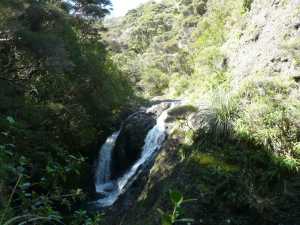
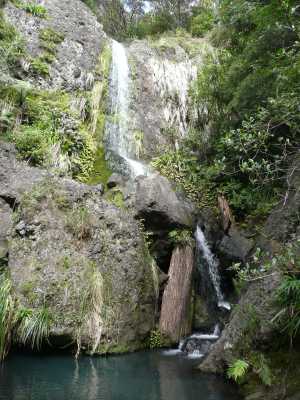
Walker Stream
Half a mile below this fall, a small stream joins in a sloping waterslide. Just 100 yards up this stream is this nice little fall with a total height (if the contours are to be believed) of 21m (70 feet). Quite satisfying to find it, the air photo showed steep ground here and there it was, just where it should be.This was on a lightly overcast day, on previous occasions the bright sun and dark shadows made photography very difficult.

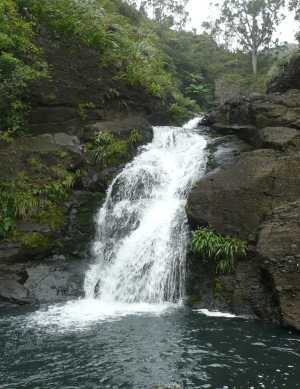


Below the gorge, the stream flattens out and runs tamely down past the campsite at Muir Track to the swamps at the back of the beach.
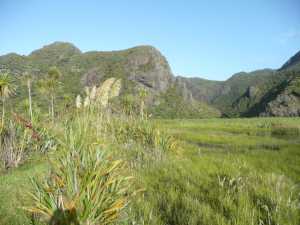
The swamps in the Pararaha valley mouth.
The valley is in the right distance.
(I know it ain't waterfall-related but I love this spot).

The coastal swamps seen from the track over the dunes south of Tunnel Point.
The Pararaha valley goes up by the low grey dunes in the distance.
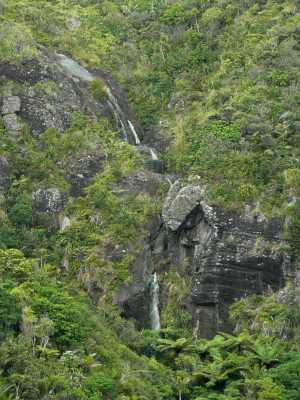
Waihuna Stream, Pararaha
From the sandy track across the swamps in Pararaha valley mouth, this ephemeral waterfall can be seen to the north, when it's flowing (which, in summer, is not often). It's on the Waihuna Stream, which has a very small catchment - a pity, since it would be quite spectacular with a bigger flow. Allowing for part of the lower fall being obscured by vegetation, and scaling off the pungas - tree ferns - at its base, the lower fall appears to be about 8m high. This is a pretty rough estimate, obviously. (Mature tree ferns in this area measure, quite consistently, just over 4m across). According to the contoured photo, the main cliff is 20m high up to the middle of the photo, and the total height of the drop is around 40 metres, which agrees.Nihotupu waterfalls
|
The Upper Nihotupu Track a.k.a. Nihotupu Dam Road is open alongside the lake as far as the dam. Also the short track on the north side of Piha Road as far as the disused dam (but only that far). |
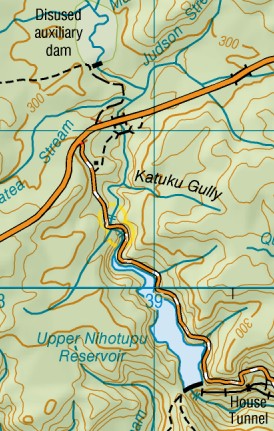
There are a number of un-named cascades and falls on the Nihotupu stream just above the lake of the Upper Nihotupu Dam, which can be seen from the track which runs down from Piha Road to cross the stream just above the the lake. The top picture shows the uppermost one.
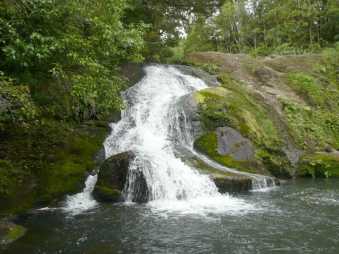
Just below the bridge across the stream is this cascade (right). There's a concrete gauging weir at the top (just visible in the photo),

(I've been told it was indeed artifical. The stream originally flowed around beside the road, it was diverted through the cut to permit quarryng at the head of the lake, to provide rock for the dam)
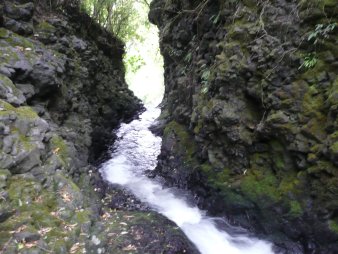
The main fall is 12m high to the top of the mossy hump (scaling off a convenient friend of known height, who was standing on the rocky beach to the right - out of shot in this photo).
There is also a waterfall below the dam which only ever flows when the dam is overflowing, which is rarely.
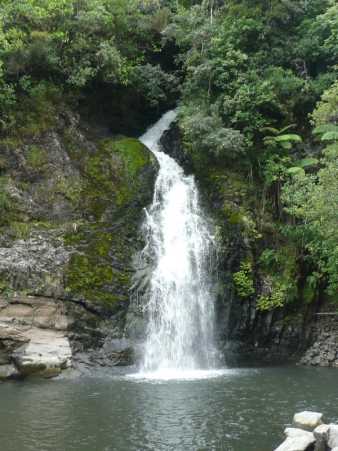

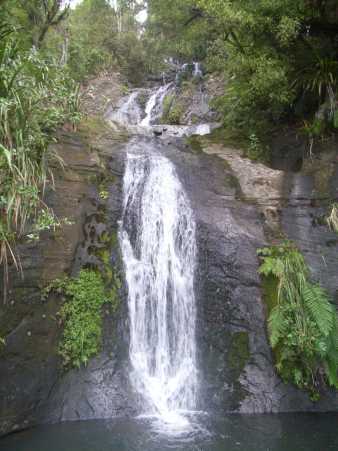
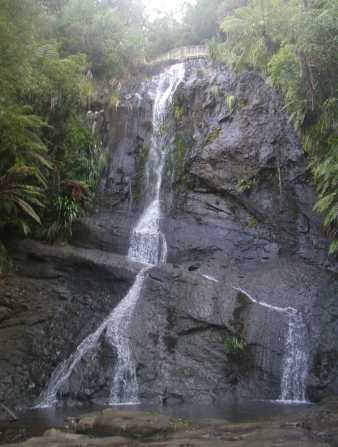
Fairy Falls
| All closed. |
On the eastern side of the ranges, reached by a walking track off the Scenic Drive, is Fairy Falls.
It's actually a cascade of quite respectable extent, the contour map suggests at least 60m (200 feet) total height, though mostly in small steps, and it would benefit from a bit more flow. The ranges generally slope to the west so catchments on this eastern side are small.
I'm not sure whether it justifies the obtrusive signage on the Scenic Drive; it's a pleasant enough walk (but a stiff climb back up the hill). I prefer the approach from the Mountain Road end, though parking is extremely limited.
The path crosses the 'falls' half-way up their height; this is the upper half of the cascade, seen from the path.
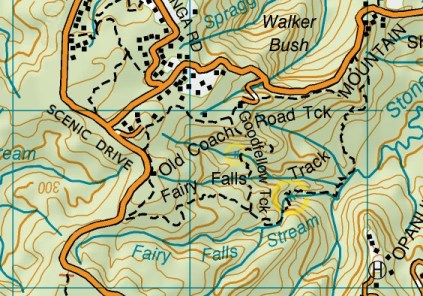
And this is the lower, steeper cascade; the flow appears to have spread itself a bit thin on the rock face. The path crossing can be seen at the top of the cliff.
It might be worth the hike after some good heavy rain to see it in better condition.
Incidentally, in walking from the Scenic Drive down to the falls, you have walked almost the whole length of the stream that feeds them!
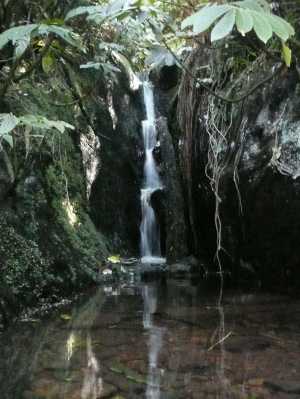

Karamatura
| All closed. What a surprise. |
Towards the southern end of the Waitakeres, surrounded by some of the highest hills in the ranges, is the Karamatura valley. Where the Karamatura Track crosses White Stream, a short branch to the right leads to a waterfall, a popular spot for picnic parties. The catchment isn't very large, so the stream is correspondingly small, though like all these streams it can get much bigger when in flood.
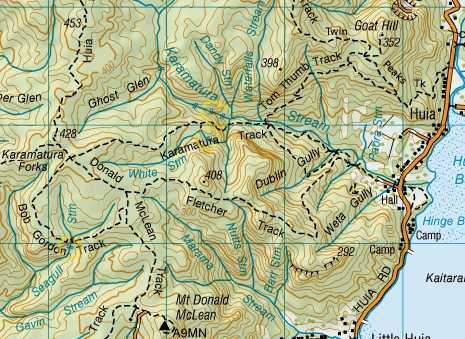

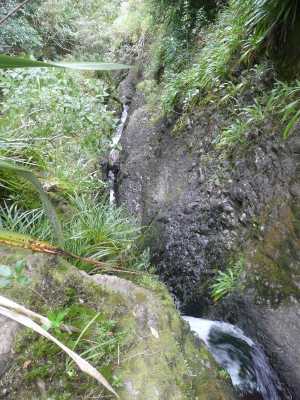

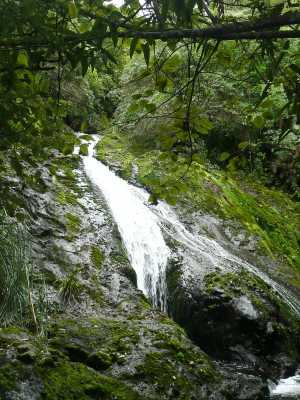
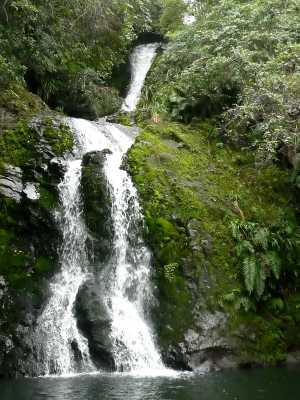

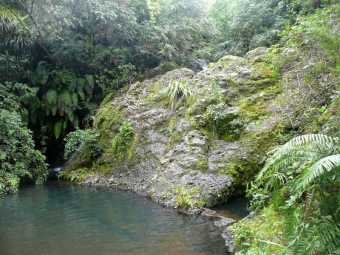
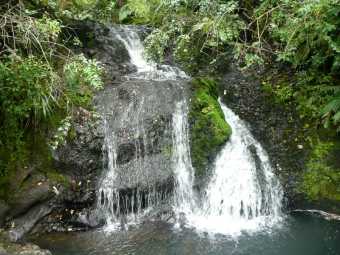

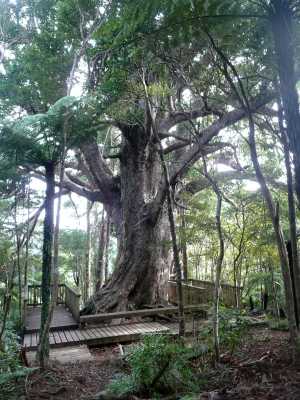
White Stream
If you continue west from where the waterfall track branched off, straight after crossing White Stream, Karamatura Track commences to climb very steeply up the valley side, for about 400 vertical feet. At the top of this long stiff climb, with a steep drop to the valley on the right, the ridge on the left abruptly eases off and a track branches off directly into the ridge, in a cut so level and straight it must surely be artificial. After 50 yards this leads to Whites Stream, flowing gently in a shallow valley, which seems quite bizarre considering the height we've just climbed.The artificial cut was, I believe, a diversion done in connection with kauri logging, to increase the flow in the Karamatura. There's probably the remains of a logging dam somewhere around.
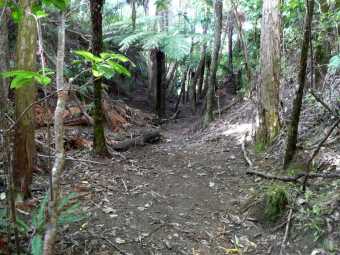
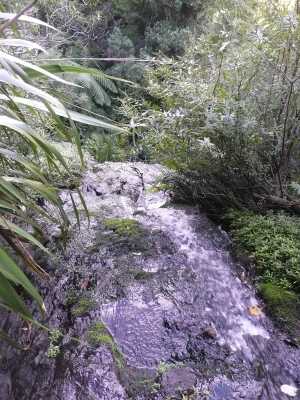
With wet slippery rocks and an unknown drop below,
this is as close to the edge as I'm going to get
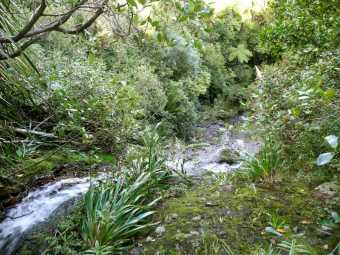
Looking down the cascade from the top edge.
Seagull Stream
| Very closed indeed. |
The flat-topped main north-south divide of the Waitakere Ranges is marked by Huia Ridge and Donald McLean Track. Just over the other side of the divide from White Stream, Bob Gordon Track does an apparently pointless loop off the Donald McLean track, part way down the side of the ridge and then back up. At its lowest point it crosses Seagull Stream, on the site of an old kauri dam, and just above a cascade. There isn't a lot of flow, since the stream catchment is so small, but the cascade is of a good height. It probably looks at its best from the valley below, but I didn't feel like finding a way down the slope through the thick bush.
Whatipu Stream
| And... closed indeed. |

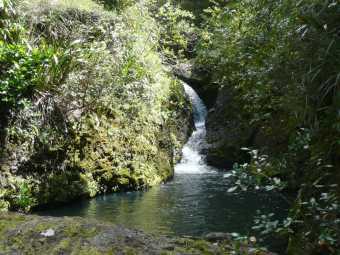
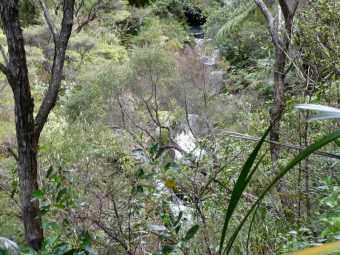
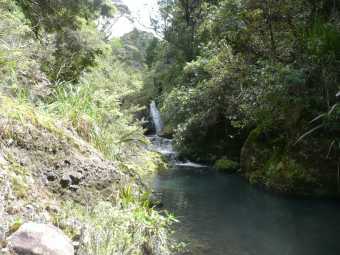
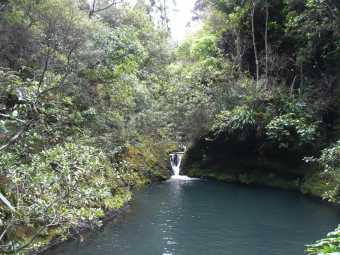

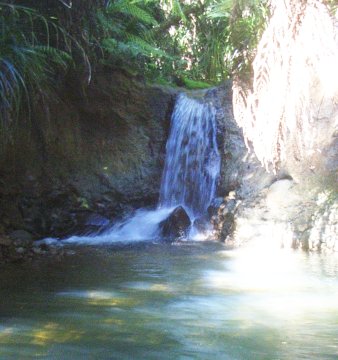
Last (and definitely least...)
| Closed, as if it matters |
And this is a joke, though I'm not sure by who or on whom. It is undeniably a waterfall, technically anyway. It's on the Esk Stream, a mile above Kitekite Falls, and it is actually marked on the latest edition of the survey map. So I went looking for it, even though the contours and the lie of the land said it couldn't be very high. I walked up the Kauri Grove Track which parallels the stream, listening intently for the roar of falling water - nothing. So I started from the ford on Lucy Cranwell Track and made my way down the stream through thick bush, cautiously so as not to risk slipping and going over the fall should I come on it unexpectedly. As it turns out this might not have caused much damage. It's all of four feet high. The waves on Piha Beach that day were higher...
I think the joke was on me.
